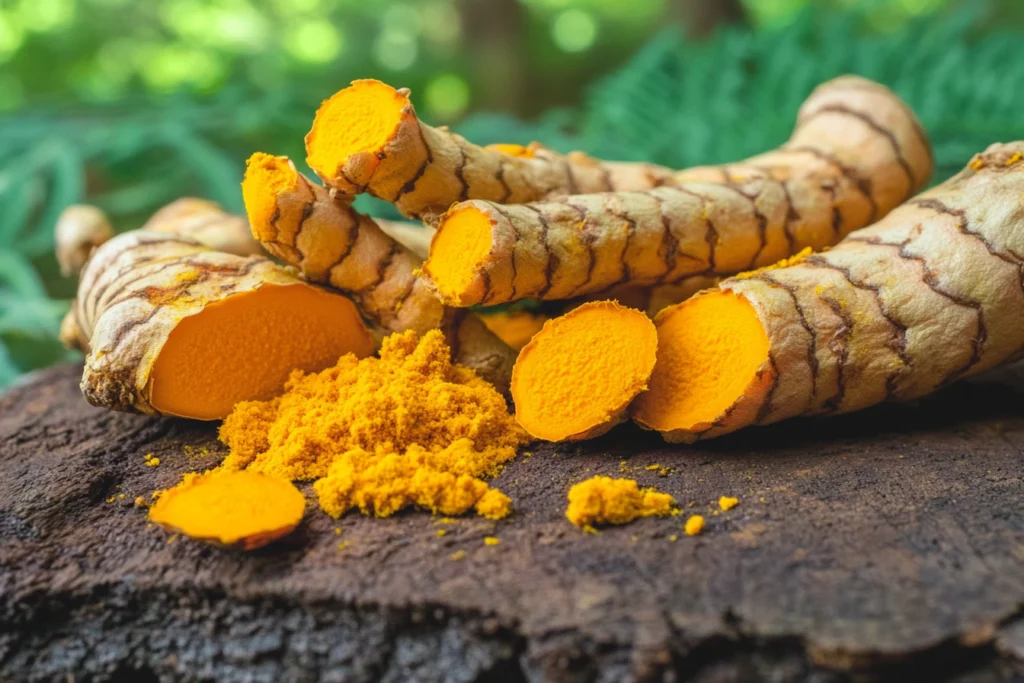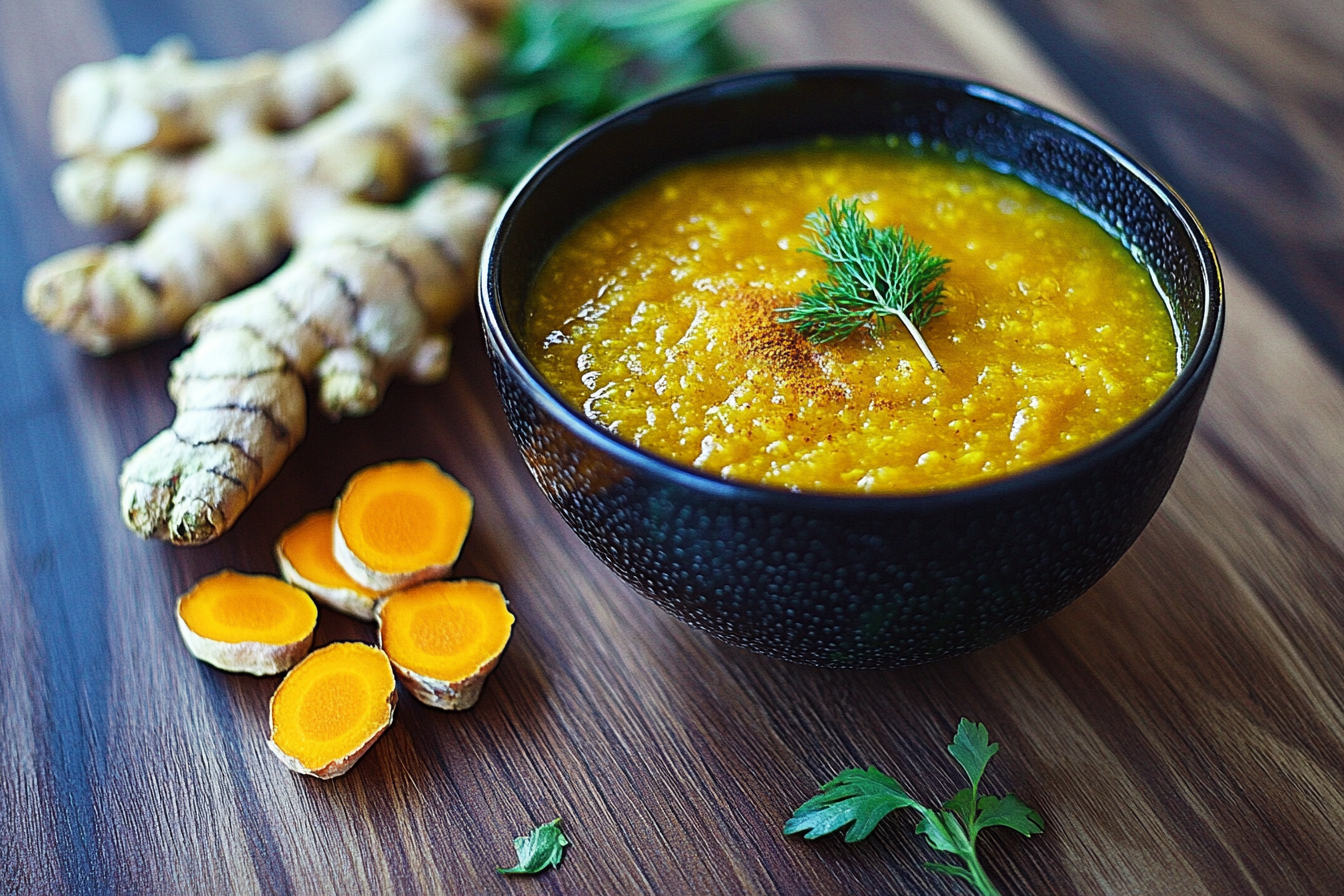Understanding Turmeric as a Spice
What does turmeric do to soup? Turmeric is a vibrant yellow spice derived from the root of the Curcuma longa plant, primarily found in South Asia. For centuries, it has been a staple in traditional Indian and Middle Eastern cuisines, valued for its distinct earthy flavour and health-enhancing properties. Known for its subtle bitterness and peppery undertones, turmeric is often used in soups, curries, and stews to add depth and richness.
Turmeric’s flavour is mild yet impactful, making it an ideal addition to various dishes. In addition to its culinary uses, it plays a significant role in Ayurvedic medicine due to its anti-inflammatory and antioxidant properties. When added to soups, turmeric hoists the flavour profile and contributes to the dish’s nutritional value, creating a perfect balance of taste and health benefits.
Nutritional Profile of Turmeric
Turmeric is packed with essential nutrients, making it a valuable addition to any meal. Here is a breakdown of its nutritional components:
- Curcumin: The active compound responsible for most of turmeric’s health benefits.
- Vitamins contain vitamin C, B6, and small amounts of vitamin E.
- Minerals: Rich in iron, potassium, manganese, and phosphorus.
- Fiber: Supports digestion and promotes a healthy gut.
- Low Calories: A teaspoon of turmeric has approximately 10 calories.
The key nutrient in turmeric is curcumin, a powerful antioxidant and anti-inflammatory compound. While turmeric contains only 3-5% curcumin, combining it with black pepper increases its bioavailability significantly. Incorporating turmeric into soups insures you get a dose of these nutrients without adding unnecessary calories, making it a healthy and practical choice.
How Turmeric Increases Soup Flavor
One of the main reasons people ask, “What does turmeric do to soup?” is its ability to improve flavour. Turmeric’s earthy and slightly bitter taste adds a layer of complexity to soups without overpowering other ingredients. Its mild flavour profile pairs well with both vegetable-based and meat-based soups.
Turmeric works harmoniously with cumin, coriander, and ginger, creating a warm and inviting flavour. For instance:
- In chicken soup, turmeric brings a subtle peppery note.
- In lentil or chickpea soup, it balances the richness of the legumes.
- Vegetable broth adds depth without overshadowing the fresh flavours.
The beauty of turmeric lies in its ability to complement other ingredients, enhancing the overall aromatic quality of your soup.
Turmeric’s Impact on Soup Color
When asking, “What does turmeric do to soup?” one cannot overlook its visual impact. Turmeric adds a golden-yellow hue to any dish, transforming dull-looking soups into vibrant and visually appealing meals. The pigment responsible for this is curcumin, which gives turmeric its signature colour.
This golden touch works particularly well in:
- Creamy soups like butternut squash or cauliflower soup.
- Clear broths such as chicken or vegetable soups.
- Hearty stews where visual appeal is as important as flavour.
The bright colour of turmeric increases the presentation, making the dish more inviting while also signalling nutrition and freshness. For chefs and home cooks, turmeric is a natural and healthier alternative to artificial colourings.
Health Benefits of Adding Turmeric to Soup

Adding turmeric to soup does more than improve flavour; it provides numerous health benefits. Here’s why turmeric is a superfood:
- Anti-Inflammatory Properties: Curcumin reduces chronic inflammation in the body.
- Rich in Antioxidants: Fights free radicals that cause oxidative stress and cell damage.
- Boosts Immunity: Helps the body combat illness and infections.
- Supports Joint Health: Relieves symptoms of arthritis and joint pain.
- Improves Heart Health: Curcumin lowers bad cholesterol and improves circulation.
By incorporating turmeric into your soups, you create a delicious and nutrient-dense meal. Regular consumption may help reduce inflammation, improve digestion, and increase overall well-being.
For an inspiring way to incorporate turmeric into your dishes, check out this turmeric chicken noodle soup recipe, which combines creative flavors with expert cooking tips.
Turmeric for Cold and Flu Relief
Adding turmeric to your soup can work wonders if you’re feeling under the weather. The key compound, curcumin, has antiviral, antibacterial, and anti-inflammatory properties that support the immune system.
Here’s how turmeric helps during cold and flu:
- It soothes a sore throat and reduces coughing.
- Acts as a natural decongestant, clearing nasal passages.
- Combats inflammation caused by infections.
- Provides warmth and comfort when consumed as turmeric soup.
A classic turmeric-improved chicken or vegetable soup with ginger, garlic, and black pepper can be a powerful remedy. This combination provides hydration and accelerates recovery, making it a perfect natural solution during flu season.
Does Turmeric Improve Gut Health?
Many people ask, “What does turmeric do to soup?” especially regarding its effects on digestion. Turmeric has been shown to improve gut health in several ways:
- Stimulates Digestion: Curcumin boosts the production of bile, which aids fat digestion.
- Reduces Inflammation: It soothes the digestive tract and helps with bloating and gas.
- Promotes Healthy Gut Bacteria: Turmeric supports the growth of beneficial bacteria, improving gut microbiome balance.
- Eases Symptoms of IBS: Curcumin reduces discomfort associated with irritable bowel syndrome.
Adding turmeric to soups can support a healthy digestive system, particularly when combined with fibre-rich vegetables or legumes. The soup’s warmth and turmeric’s soothing properties make it an ideal choice for people with sensitive stomachs.
Pairing Turmeric with Other Spices in Soup
To fully open the benefits of turmeric, it’s essential to pair it with complementary spices. Turmeric works best when combined with ingredients that improve its flavour and bioavailability. Here are some top spice pairings:
- Black Pepper: Contains piperine, which increases curcumin absorption.
- Ginger: Adds warmth and complements turmeric’s earthy notes.
- Cumin: Provides a nutty flavour that balances turmeric’s bitterness.
- Coriander: Increases the overall aroma and freshness of soups.
- Cinnamon: Adds subtle sweetness to balance savoury soups.
Try a turmeric-infused lentil soup with black pepper, cumin, and coriander for an effective and flavorful combination. These spices work synergistically, enhancing the flavour profile while delivering health benefits.
Turmeric pairs wonderfully with root vegetables and grains, as seen in this warm potato salad recipe, where its earthy tones boost the dish’s overall appeal.
So, what does turmeric do to soup? It does much more than improve flavour. From providing a golden colour and earthy taste to boosting immunity and gut health, turmeric transforms simple soups into nutritious and flavorful meals. Its anti-inflammatory properties and other spices like black pepper and ginger make turmeric a versatile addition to any kitchen.
By incorporating turmeric into your soups, you boost their taste and create meals that promote health and well-being. Turmeric is the ultimate ingredient whether you’re looking for relief from a cold, improved digestion, or simply a deliciously warm dish.
Tips for Using Fresh Turmeric in Soup
Fresh turmeric can hoist soups with its vibrant colour and earthy flavour. To maximize its benefits, follow these tips:
- Peel It Properly: Use a spoon or peeler to gently remove the thin skin of fresh turmeric. Avoid over-peeling to retain nutrients.
- Grate or Slice: Grating fresh turmeric allows for better distribution of flavour. Thinly slicing works well for subtle infusions.
- Add Towards the End: Fresh turmeric loses potency when overcooked. Add it during the last 10-15 minutes of simmering.
- Pair It Wisely: Combine turmeric with ginger, black pepper, and coconut milk to increase flavour and absorption.
- Use in Small Amounts: Fresh turmeric has a strong flavour. Start with a small amount and adjust to taste.
These tips assure fresh turmeric blends ideally into your soups, creating a flavorful and nutrient-rich dish.
Turmeric’s Role in Detoxifying Soups

What does turmeric do to soup? Turmeric is renowned for its natural detoxifying properties, making it an essential addition to health-focused soups.
- Liver Detoxification: Turmeric contains curcumin, which helps the liver flush out toxins.
- Anti-Inflammatory Effects: Curcumin helps reduce inflammation, improving overall digestive health.
- Increases Digestion: Adding turmeric to soup aids in breaking down fats and improving gut function.
- Boosts Antioxidant Levels: Turmeric combats free radicals, which can accumulate due to environmental toxins.
Detox soups often combine turmeric with ingredients like lemon, coriander, and greens for maximum benefits. By including turmeric, you transform simple soups into powerful detoxifiers that cleanse your system while providing comfort and nutrition.
How Turmeric Boosts Metabolism in Soup Recipes
What does turmeric do to soup? Adding turmeric to a soup can boost metabolism, aiding in weight management and overall energy levels.
- Curcumin’s Role: Curcumin accelerates metabolic processes, helping the body burn calories more efficiently.
- Thermogenic Effect: Turmeric increases body heat slightly, encouraging fat breakdown.
- Improves Digestion: Better digestion insures fewer toxins accumulate, which can slow metabolism.
- Reduces Fat Storage: By reducing inflammation, turmeric may prevent fat accumulation in tissues.
To maximize these effects, include turmeric in soups rich in lean protein, fibre, and healthy fats. Ingredients like lentils, beans, and vegetables pair perfectly, providing a balanced meal that fuels metabolism while keeping you satiated.
Turmeric’s Role in Vegan and Plant-Based Soups
What does turmeric do to soup? For vegan and plant-based soups, turmeric serves as a flavour increaser, nutrient booster, and natural food colouring.
- Rich in Nutrients: Fresh and ground turmeric adds vitamins and antioxidants essential for a vegan diet.
- Balances Flavors: Its earthy, slightly bitter notes complement sweet vegetables like carrots, sweet potatoes, and butternut squash.
- Adds Protein Absorption Support: Pair turmeric with legumes such as chickpeas or lentils, as curcumin increases nutrient absorption.
- Natural Color: Turmeric gives soups a vibrant golden hue without artificial additives.
Turmeric blends effortlessly into coconut-based broths, lentil soups, and spiced vegetable stews. It makes plant-based soups visually appealing and boosts their nutritional profile.
Comparing Fresh Turmeric and Ground Turmeric in Soups
When deciding between fresh and ground turmeric, understanding their differences insures the best choice for your soups.
Fresh Turmeric
- Flavor: Fresh turmeric has a bold, peppery taste with hints of ginger.
- Usage: Best when grated, minced, or sliced. Ideal for recipes that benefit from raw flavours.
- Nutrient Density: Fresh turmeric retains more natural oils and nutrients.
- Shelf Life: Must be stored properly and used quickly, as it spoils faster.
Ground Turmeric
- Flavor: Milder and slightly earthy compared to fresh turmeric.
- Convenience: Easily measured and stored; a teaspoon of ground turmeric equals about an inch fresh.
- Stability: Long shelf life and ideal for soups requiring longer cooking times.
- Potency: While processed, it still retains a significant amount of curcumin.
What does turmeric do to soup? Whether fresh or ground, both types offer impressive health benefits. Use fresh turmeric for intense flavours and ground turmeric for convenience.
For cooks seeking an extra twist to classic snacks, you can also consider this take on coconut oil for popcorn popping, where turmeric can add color and a healthful kick.
FAQs
1. What does turmeric do to soup?
Turmeric increases the flavour, adds a natural golden hue, and boosts the soup’s anti-inflammatory and antioxidant properties.
2. Can I use both fresh and ground turmeric together?
Yes. Combining fresh and ground turmeric amplifies the flavour and insures a consistent golden colour.
3. How much turmeric should I add to the soup?
Start with 1-2 teaspoons of grated turmeric per pot for fresh turmeric. For ground turmeric, use 1 teaspoon and adjust to taste.
4. Does turmeric lose its benefits when cooked?
Cooking turmeric slightly reduces its potency, but pairing it with black pepper and healthy fats helps retain curcumin absorption.
5. What soups pair well with turmeric?
Turmeric pairs perfectly with lentil soup, coconut milk-based broths, root vegetable soups, and spiced vegan stews.
Turmeric is a powerhouse ingredient that increases soups’ flavour, nutritional value, and overall appeal. Understanding what turmeric does to soup can create detoxifying, metabolism-boosting, and plant-based recipes that stand out. Whether you choose fresh turmeric for its robust flavour or ground turmeric for convenience, this golden spice is essential for health-focused cooking. Add turmeric thoughtfully to enjoy its many benefits and hoist your soups to a new level of wellness and taste.

